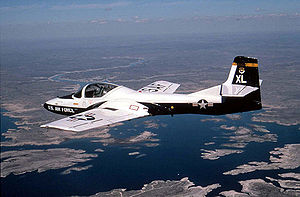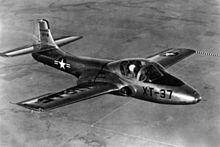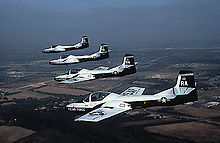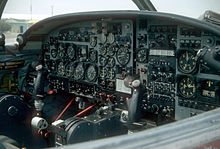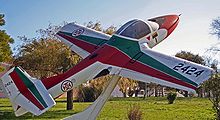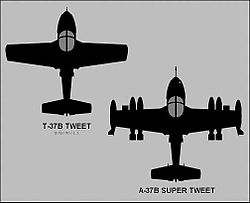- Cessna T-37 Tweet
-
This article is about the twin engine Cessna primary jet training aircraft. For other uses, see T37 (disambiguation). For the T-48TS, see T-48 MPATS.
T-37 Tweet A T-37 Tweet from the 85th Flying Training Squadron, Laughlin Air Force Base, Texas, flies over Amistad Reservoir during a training mission. Role Military trainer aircraft Manufacturer Cessna First flight October 1954 Introduction 1957 Primary users United States Air Force
Brazilian Air Force
Pakistan Air Force
Portuguese Air ForceProduced 1955-1975 Number built 1,269 Variants A-37 Dragonfly The Cessna T-37 Tweet[1] (designated Model 318 by Cessna[2]) is a small, economical twin-engine jet trainer-attack type aircraft which flew for decades as a primary trainer for the United States Air Force (USAF) and in the air forces of several other nations. The A-37 Dragonfly variant served in the light attack role during the Vietnam War and continues to serve in the air forces of several South American nations.
The T-37 served as the U.S. Air Force's primary pilot training vehicle for over 52 years after its first flight. After completing Primary in the Tweet, students moved on to other advanced Navy, Marine Corps or Allied trainers. 1,269 Cessna T-37s were built, with 419 still serving in the United States Air Force in 2006. Between 2001 and 31 July 2009 the USAF phased out the T-37 in favor of the T-6 Texan II.[3]
Contents
Development
Origins
The Cessna Aircraft Company of Wichita, Kansas provided the United States Army during World War II and the Korean War with utility, light transport, and observation aircraft, particularly the "O-1 Bird Dog" series.
In the spring of 1952 the United States Air Force (USAF) issued a request for proposals for a "Trainer Experimental (TX)" program, specifying a lightweight two-seat basic trainer for introducing USAF cadets to jet aircraft.
Cessna responded to the TX request with a twin-jet design with side-by-side seating. The USAF liked the Cessna design, which was given the company designation of "Model 318", and the side-by-side seating since it let the student and instructor interact more closely than with tandem seating. In the spring of 1954, the USAF awarded Cessna a contract for three prototypes of the Model 318, and a contract for a single static test aircraft. The Air Force designated the type as XT-37.
The XT-37 had a low straight wing, with the engines buried in the wing roots, a clamshell-type canopy hinged to open vertically to the rear, a control layout similar to that of contemporary operational USAF aircraft, ejection seats, and tricycle landing gear with a wide track of 4.3 m (14 ft). It first flew on October 12, 1954.[4]
The wide track and a steerable nosewheel made the aircraft easy to handle on the ground, and the short landing gear avoided the need for access ladders and service stands. The aircraft was designed to be simple to maintain, with more than a hundred access panels and doors. An experienced ground crew could change an engine in about a half hour.
The XT-37 was aerodynamically clean, so much so that an air brake was fitted behind the nosewheel door to help reduce speed for landing. Since the short landing gear placed the engine air intakes close to the ground, screens pivoted over the intakes from underneath when the landing gear was extended, to prevent foreign object damage.
The XT-37 was fitted with two Continental-Teledyne J69-T-9 turbojet engines, French Turbomeca Marboré engines built under license, with 920 lbf (4.1 kN) thrust each. The engines had thrust deflectors to allow them to remain spooled-up (i.e. rotating at speeds above idle) during landing approach, permitting shorter landings while still allowing the aircraft to easily make another "go-round" in case something went wrong. Empty weight of the XT-37 was 2.27 tonnes (5,000 lb).
Tests showed the XT-37 had a maximum speed of 628 km/h (390 mph) at altitude, with a range of 1,505 km (935 mi). The aircraft was unpressurized, and so limited to a ceiling of 7.6 km (25,000 ft) by USAF regulations.
The initial prototype crashed during spin tests. Later prototypes had new features to improve handling, including long strakes along the nose, and an extensively redesigned and enlarged tail. After these modifications the USAF found the aircraft acceptable to their needs, and ordered it into production as the T-37A. Production aircraft remained tricky in recovering from a spin; the recovery procedure was complex compared with most aircraft.
 A panorama of T-37s at Sheppard AFB, part of the NATO fleet
A panorama of T-37s at Sheppard AFB, part of the NATO fleet
Production
The production T-37A was similar to the XT-37 prototypes, except for minor changes to fix problems revealed by the flight test program. The first T-37A was completed in September 1955 and flew later that year.
The T-37A was very noisy, even by the standards of a jet aircraft. The intake of air into its small turbojets emitted a high-pitched shriek that led some to describe the trainer as a "Screaming Mimi", and it was referred to as the "6,000 pound dog whistle" or "Converter" (converts fuel and air into noise and smoke).[5][6] The piercing whistle quickly gave the T-37 its name: "Tweety Bird", or just "Tweet". The Air Force spent a lot of time and money sound-proofing buildings at bases where the T-37 was stationed, and ear protection remains mandatory for all personnel when near an operating aircraft.
The Air Force ordered 444 T-37As, with the last produced in 1959. During 1957, the US Army evaluated three T-37As for battlefield observation and other combat support roles, but eventually procured the Grumman OV-1 Mohawk instead.
The Air Force liked the T-37A, but considered it to be underpowered; consequently they ordered an improved version, the T-37B, with uprated J-69-T-25 engines. The new engines provided about 10% more thrust and were more reliable. Improved avionics were also specified for the new variant.
A total of 552 newly-built T-37Bs were constructed through 1973. All surviving T-37As were eventually upgraded to the T-37B standard as well.
Due to a series of accidents caused by bird strikes between 1965 and 1970, all T-37s were later retrofitted with a new windscreen made of Lexan polycarbonate plastic 12.5 mm (½in) thick, which could tolerate the impact of a 1.8 kg (4 lb) bird at a relative speed of 460 km/h (288 mph).
In 1962 Cessna suggested the T-37B as a replacement for the North American F-100 Super Sabre as the primary aircraft for the USAF aerobatic demonstration team, the Thunderbirds, but the USAF was satisfied with the F-100.
The T-37A and T-37B had no built-in armament and no stores pylons for external armament. In 1961 Cessna began developing a modest enhancement of the T-37 for use as a weapons trainer. The new variant, the T-37C, was intended for export and could be used for light attack duties if required.
The prototype T-37C was a modified T-37B. The primary changes included stronger wings, with a stores pylon under each wing outboard of the main landing gear well. The T-37C could also be fitted with wingtip fuel tanks, each with a capacity of 245 l (65 US gallons), that could be dropped in an emergency.
A computing gunsight and gun camera were added. The T-37C could also be fitted with a reconnaissance camera mounted inside the fuselage.
The primary armament of the T-37C was the General Electric "multi-purpose pod" with a 12.7 mm (0.50 caliber) machine gun with 200 rounds, two 70 mm (2.75 in) folding-fin rockets, and four practice bombs. Other stores, such as folding-fin rocket pods or Sidewinder air-to-air missiles, could be carried.
The changes increased the weight of the T-37C by 650 kg (1,430 lb). As the engines were not upgraded, this reduced top speed to 595 km/h (370 mph), though the wingtip tanks increased maximum range to 1,770 km (1,100 mi).
T-37 production ended in 1975. The list of exports above amounts to 273 T-37Cs. Adding this to the 444 T-37As and 552 T-37Bs gives a total of 1,269 aircraft built.
Concept aircraft
Cessna proposed a number of innovative variants of the Tweet that never went into production. In 1959, Cessna built a prototype of a light jet transport version of the T-37, designated the Cessna Model 407, which was stretched 61 cm (2 ft) to accommodate a four-place pressurized cockpit with an automobile-type configuration. Only a wooden mockup of the "Model 407" was constructed. The project was canceled due to insufficient customer interest.[7]
The company also proposed a similar four-place military light transport, the "Model 405", with a big clamshell canopy, but it was never built.
In response to a United States Navy "Tandem Navy Trainer" (TNT) requirement, Cessna proposed a T-37 with a modified fuselage featuring a tandem cockpit. The Navy selected the North American T-2 Buckeye instead.
Cessna proposed various other trainer derivatives for the US Navy and Air Force, including a vertical takeoff version based on the TNT configuration and incorporating lift-jet pods in the wings, but none of them got to the prototype stage.
Operational history
The T-37A was delivered to the U.S. Air Force beginning in June 1956. The USAF began cadet training in the T-37A during 1957. The first T-37B was delivered in 1959. Instructors and students considered the T-37A a pleasant aircraft to fly. It handled well and was agile and responsive, though it was definitely not overpowered. It was capable of all traditional aerobatic maneuvers. Students intentionally placed the aircraft into a spin as part of their pilot training.
The Air Force made several attempts to replace the T-37 (including the T-46), but it remained in service with the USAF until it was phased out in favor of the Beechcraft T-6A Texan II between 2001 and 2009. The T-6 is a turboprop aircraft with more power, better fuel efficiency and more modern avionics than the Tweet.
The final USAF student training sortie by a T-37B aircraft in the Air Education and Training Command (AETC) took place on 17 June 2009. The last USAF operator of the T-37B, the 80th Flying Training Wing (80 FTW), flew the sortie from its home station at Sheppard AFB, Texas. The last T-37B was officially retired from active USAF service on 31 July 2009.[3]
Survivors
- XT-37 on display at the Mid-America Air Museum in Liberal, Kansas
- T-37A on display at the Yanks Air Museum in Chino, California (awaiting restoration)
- T-37B, AF Ser. No. 57-2289, on display at the National Museum of the United States Air Force at Wright-Patterson Air Force Base in Dayton, Ohio
- T-37B on display at Columbus Air Force Base in Columbus, Mississippi
- T-37A on display at Laughlin Air Force Base in Del Rio, Texas
- T-37B on display at Vance Air Force Base in Enid, Oklahoma
- T-37B on display near the Randolph Inn Visiting Officers Quarters/Distinguished Visitors Quarters complex at
Randolph Air Force Base in San Antonio, Texas - T-37B, AF Ser. No. 54-2734, on display at Dyess Linear Air Park at Dyess Air Force Base in Abilene, Texas
- T-37B, AF Ser. No. 57-2261, on display at the Museum of Aviation at Robins Air Force Base in Warner Robins, Georgia
- T-37B, AF Ser. No. 57-2259, on display at the Hill Aerospace Museum at Hill Air Force Base in Ogden, Utah
- T-37B, AF Ser. No. 57-2316, on display at the March Field Air Museum at March Air Reserve Base in Riverside, California
- T-37B, AF Ser. No. 54-2736, on display at the Grissom Air Museum at Grissom Air Reserve Base in Peru, Indiana
- T-37B on display at Battle Creek Air National Guard Base in Battle Creek, Michigan
- T-37B, Ser. No. 57-2267, on display at the Pima Air & Space Museum, adjacent to Davis-Monthan Air Force Base in Tucson, Arizona
- T-37 on display at the Perrin Air Force Base Museum at North Texas Regional Airport (former Perrin Air Force Base) in Denison, Texas
- T-37B, AF Ser. No. 55-4305, on display at the Hangar 25 Air Museum at Big Spring McMahon-Wrinkle Airport
(former Webb Air Force Base) in Big Spring, Texas - T-37B on display at Craig Field Airport and Industrial Complex (former Craig Air Force Base) in Selma, Alabama
- T-37B on display at Bartow Airport (former Bartow Air Base), Bartow, Florida
- T-37B on display at the Olympic Flight Museum in Olympia, Washington
- T-37B, AF Ser. No. 58-1977, on display at the Kansas Aviation Museum in Wichita, Kansas[8]
- T-37B on display at the Estrella Warbirds Museum in Paso Robles, California
- T-37B on display at the Southern Museum of Flight in Birmingham, Alabama
- T-37B on display at the Pueblo Weisbord Aircraft Museum in Pueblo, Colorado
- T-37B, Ser. no 57-2247 on display at Norsk Luftfartsmuseum in Bodø, Norway
- T-37C on display (registration no. unconfirmed) at Royal Thai Air Force Museum, Don Muang Royal Thai Air Force Base
- T-37C on display at the War Memorial of Korea, Seoul, South Korea.
- T-37 on display at the Tulsa Air & Space Center in Tulsa, Oklahoma
- T-37 on display at the Confederate Air Force Highland Lakes Squadron Air Museum (Hill County Squadron) in Burnet, Texas
- T-37 on display at the Confederate Air Force Ranger Wing at Waco Regional Airport in Waco, Texas
- T-37 on display at Base Aérea el Bosque in Santiago, Chile
- T-37 VNAF on display at the Can Tho Museum of People's Armed Forces, Viêt-Nam (heavily damaged by time)
- T-37 on display at the Cherokee County Veterans Museum in Gaffney, South Carolina
- T-37 on display at the Museo Nacional Aeronautico y del Espacio in Los Cerrillos, Santiago, Chile.
- At least two airworthy T-37s and six A-37s are currently registered under private ownership with the FAA and are currently flying.
- T-37b on display at the secretaria de las fuerza armadas. Santo Domingo Dominican Republic
Variants
- XT-37A
- Two-seat jet trainer prototype aircraft, powered by two Continental YJ69-T-9 turbojet engines; two built.
- T-37A
- Two-seat basic jet trainer aircraft, powered by two Continental J69-T-9 turbojet engines; 534 built.
- T-37B
- Two-seat basic jet trainer aircraft, powered by two Continental J69-T-25 turbojet engines, fitted with improved navigation and communications equipment.
- T-37C
- Two-seat basic jet trainer, light-attack aircraft, fitted with two weapons pylons, one under each wing; 269 built.
- XAT-37D
- Two-seat counter-insurgency, light-attack prototype aircraft; two built.
Operators
T-37s, including both new-build and ex-USAF aircraft, were supplied to a number of countries, including:
 Bangladesh
Bangladesh- 30 aircraft, including 12 Cessna T-37 Tweet in active service.
 Brazil
Brazil- Brazilian Air Force - 65 T-37Cs, later passing 30 on to South Korea and 12 on to Paraguay, which were never delivered due to US veto.
 Burma
Burma- Burmese Air Force - 12 T-37Cs.
 Cambodia
Cambodia- Royal Cambodian Air Force - 4 T-37Bs.
 Chile
Chile- Chilean Air Force - 32 aircraft, including 20 T-37Bs and 12 T-37Cs.
 Colombia
Colombia- Colombian Air Force - 14 aircraft, including 4 T-37Bs and 10 T-37Cs.
 Ecuador
Ecuador- Ecuadorian Air Force - 10 T-37Bs.
 Germany
Germany- Luftwaffe - 47 T-37Bs now retired, superseded by the T-6 Texan II
 Greece
Greece- Hellenic Air Force - 32 aircraft, including 8 T-37Bs and 24 T-37Cs.
 Jordan
Jordan- Royal Jordanian Air Force - 15 aircraft, apparently ex-USAF T-37Bs.
 Morocco
Morocco- Royal Moroccan Air Force - 14 aircraft, received in 1995
 Pakistan
Pakistan- Pakistan Air Force - 63 aircraft, including 24 T-37Bs and 39 T-37Cs. Another 20 T-37s are on order from the U.S.[11]
 Peru
Peru- Peruvian Air Force - 32 T-37Bs.
 Portugal
Portugal- Portuguese Air Force - 30 T-37Cs. Some T-37Cs were used as the primary aircraft for the aerobatic demonstration team, the Asas de Portugal (Wings of Portugal) starting in 1977.
 South Korea
South Korea- South Korean Air Force - originally 25 T-37Cs, plus 30 later bought from Brazil. First introduction Time : June, 1973.
 South Vietnam
South Vietnam- Vietnam Air Force - 24 T-37Bs.
 Thailand
Thailand- Royal Thai Air Force - 16 aircraft, including 10 T-37Bs and 6 T-37Cs.
 Turkey
Turkey- Turkish Air Force - 65 T-37Cs.
 United States
United States- United States Air Force
 Vietnam
Vietnam- Vietnam People's Air Force - captured ex-South Vietnamese T-37s
Specifications (T-37B)
Data from [12]
General characteristics
- Crew: 2
- Length: 29 ft 3 in (9 m)
- Wingspan: 33 ft 9 1/3 in (10.1 m)
- Height: 9 ft 2 in (2.8 m)
- Empty weight: 4,056 lb (1,840 kg)
- Max takeoff weight: 6,569 lb (2,980 kg)
- Powerplant: 2 × Continental-Teledyne J69-T-25 turbojets, 1,025 lbf (4.56 kN) each
Performance
- Maximum speed: 425 mph (369 knots, 684 km/h)
- Range: 810 NM (932 mi, 1,500 km)
- Service ceiling: 25,000 ft (7,620 m)
Armament
- Total stores stations: None (T-37A/B), 2 underwing for stores up to 500 lb (227 kg) (T-37C)
See also
- Related development
- Aircraft of comparable role, configuration and era
- Saab 105
- BAC Jet Provost
- Boeing Skyfox
- Canadair CT-114 Tutor
- Temco TT Pinto
- Related lists
References
Citations
- ^ DoD 4120-15L, Model Designation of Military Aerospace Vehicles. US DoD, 12 May 2004.
- ^ http://www.marchfield.org/t37.htm
- ^ a b Sheppard, AF officials retire workhorse of pilot training
- ^ Taylor 1965, pp. 208–209.
- ^ http://books.google.com/books?id=Cr20MURP3XAC&pg=PA7&lpg=PA7&dq=tweet+nicknames+-sweet+T-37&source=bl&ots=B5B-jqYxhH&sig=sl2z-s3x6zZuSMcRQ4zSseSDC5Q&hl=en&ei=45yxSuuXPIGxtgehi_mRCA&sa=X&oi=book_result&ct=result&resnum=1#v=onepage&q=tweet%20nicknames%20-sweet%20T-37&f=false
- ^ http://www.google.com/search?q=tweet+nicknames+-sweet+T-37+%22dog+whistle%22+convertor&ie=utf-8&oe=utf-8&aq=t&rls=org.mozilla:en-US:official&client=firefox-a
- ^ Van Bavel, Luc (September 1959). "Cessna 407". http://www.machdiamonds.com/cessna407.html. Retrieved 2008-08-17.
- ^ http://www.kansasaviationmuseum.org/images/ac-t37b-big.jpg
- ^ U.S. Military Aircraft and Weapon Designations, T - Trainer Aircraft
- ^ Parsch, Andreas and Jos Heyman. Designation-Systems.net: Duplications in U.S. Military Aircraft Designation Series
- ^ Govindasamy, Siva. "Pakistan to receive more T-37 trainers", Flight International, 21 August 2008.
- ^ Love, 1991. p. 11
Sources
- Love, Terry. A-37/T-37 Dragonfly. Carrollton, TX: Squadron/Signal Publications, 1991
- Taylor, John W. R. Jane's All The World's Aircraft 1965-66. London: Sampson Low, Marston, 1965.
The initial version of this article was based on a public domain article from Greg Goebel's Vectorsite.
External links
Cessna aircraft Single-engine A · AA · AC · AF · AS · AW · BW · CR-2 · CR-3 · CW-6 · EC-1 · EC-2 · DC-6 · C-34 · C-37 · C-38 · C-145 · C-165 · 120 · 140 · 150 · 152 · 160 · 162 · 170 · 172 · 175 · 177 · 180 · 182 · 185 · 187 · 188 · 190 · 195 · 205 · 206 · 207 · 208 · 210 · 305 · 308 · 309 · 319 · 321 · 325 · 350 · 400 · 1014 · 1034 · NGP · XMC
Multi-engine Cessna Citation
familiesHelicopters Gliders Military USAAC/USAAF/USAF/Tri-service trainer aircraft Advanced Trainer Basic Combat Basic Trainer Primary Trainer (1924-1948) Trainer (1948-1990) "T-1", "T-2", "T-3" and "T-6" have also been assigned since 1962 in a separate sequence.Lists relating to aviation General Aircraft (manufacturers) · Aircraft engines (manufacturers) · Airlines (defunct) · Airports · Civil authorities · Museums · Registration prefixes · Rotorcraft (manufacturers) · TimelineMilitary Accidents/incidents Records Categories:- Cessna aircraft
- United States military trainer aircraft 1950–1959
Wikimedia Foundation. 2010.

